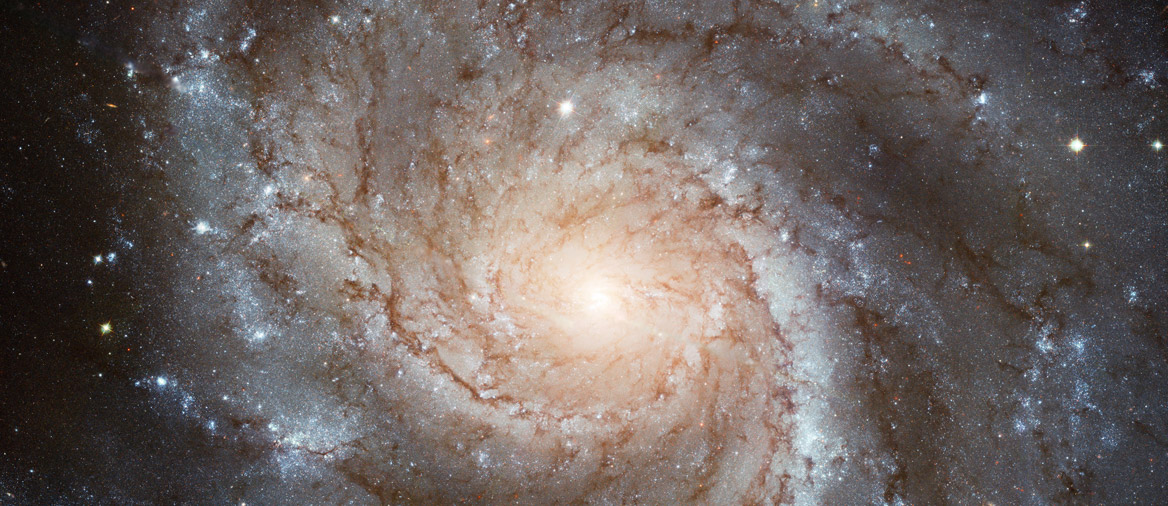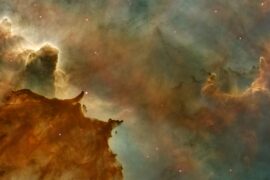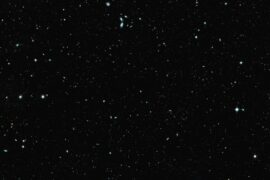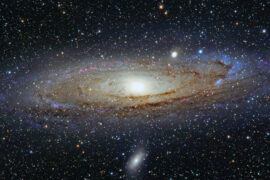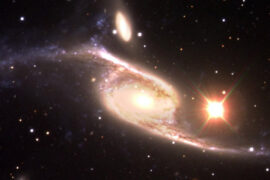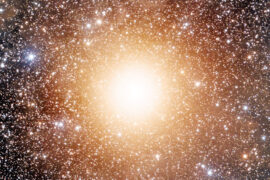The Pinwheel Galaxy is 17 times bigger than our galaxy, the Milky Way. It is one of the most easily recognizable deep sky objects in the night sky. Even though it is very far away at a distance of almost 21 million light-years (10 times farther away than the Andromeda galaxy), it is so large and bright that it is easily visible with an amateur telescope.
That and its very distinctive shape of a pinwheel, make it one of the most common targets of study for amateur and professional astronomers.
In this article, we’ll learn some cool facts about the Pinwheel Galaxy and its characteristics. Let’s get started.
Pinwheel Galaxy Fact Sheet
| Nickname | Pinwheel Galaxy | |
| Designations | Messier 101 (M101), NGC 5457, UGC 8981, PGC 50063, Arp 26 | |
| Type | Spiral galaxy (SAB(rs)cd) | |
| Location in the sky | Ursa Major constellation | |
| Distance from Earth | 21 million light-years (6.4 megaparsecs) | |
| Age | 10 – 15 billion years old | |
| Diameter | 170,000 light-years (52.1 Kiloparsecs) | |
| Apparent magnitude | 7.9 | |
| Radial velocity | 241 km/s | |
| Right ascension | 14h 03m 12.6s | |
| Declination | +54° 20′ 57″ | |
| Redshift | 0.000804 | |
| Number of stars | At least 1 trillion |
Pinwheel galaxy facts

Quick facts
- Most of the stars in the Pinwheel galaxy are born in the arms which can clearly be observed due to the position of the galaxy in relation to us. There are more than 3,000 star-forming regions in these arms.
- The Pinwheel Galaxy is located 21 million light-years away from Earth. That is 10 times farther away than the Andromeda Galaxy.
- This means that what we see today on Earth is what happened 21 million years ago in the Pinwheel Galaxy. That is longer than the whole history of humankind.
- The Pinwheel galaxy is 17 times wider than our galaxy, the Milky Way, making it considerably larger.
- Likewise, astronomers estimate that the Pinwheel Galaxy contains at least 10 times more stars than the Milky Way. It is very likely that means that there could be over one trillion stars within its borders.
- It was discovered by the French astronomer Pierre Méchain
- There are two other galaxies that are sort of named “Pinwheel Galaxy”. These are the Southern Pinwheel Galaxy (M83), and the Coma Pinwheel Galaxy (M99).
- It is sometimes confused with the Triangulum Galaxy (M33) and Cartwheel Galaxy (ESO 350-40) because of their similar shapes.
- Unlike most galaxies, the Pinwheel Galaxy does not have a supermassive black hole as its core. Instead, it appears to have multiple smaller black holes that are “just” 20-30 times larger than our Sun.
- The Pinwheel Galaxy can be found in the direction of the Ursa Major constellation.
- The Pinwheel Galaxy is the largest of a group of galaxies called the M101 group. These smaller “companion” galaxies (NGC 5204, NGC 5474, NGC 5477, NGC 5585, UGC 8837, and UGC 9405) travel along with the Pinwheel galaxy and have gravitational interaction with it. They are probably the reason why the Pinwheel galaxy is asymmetrical.
Discovery
The Pinwheel Galaxy was discovered by the French astronomer Pierre Méchain in 1781.
Méchain was a contemporary and colleague of Charles Messier who is well-known for being the creator of the Messier catalog, one of the first organized archives of deep-space objects that is still widely used to this day.
The Pinwheel Galaxy was assigned the number 101 in the Messier catalog and that’s why it is sometimes referred to as Messier 101 or M101 for short.
Naming
As explained in our post about galaxy names, there is no convention for the proper names of galaxies. And since there are millions of galaxies out there, it would be impossible to assign a meaningful name to all of them. The International Astronomical Union has opted instead to only give scientific designations to galaxies and only those that were discovered early have kept their proper names.
The pinwheel galaxy was named because it looks like a pinwheel. It really is that simple. A pinwheel is a children’s toy that is made of curls of paper or plastic attached to a stick. While a lot of galaxies have a similar shape, the position of the pinwheel galaxy allows us to see it from “above” where all of its arms and elliptical shape are easy to observe.
The Pinwheel galaxy also has other scientific designations. Each catalog of stars and celestial objects assigns each object an identifier so a galaxy can have many different names or designations. Some of the designations for the Pinwheel Galaxy are:
- Messier 101 (Messier Catalogue)
- NGC 5457 (New General Catalogue of Nebulae and Clusters of Stars)
- UGC 8981 (Uppsala General Catalogue of Galaxies)
- PGC 50063 (Catalogue of Principal Galaxies)
- Arp 26 (Atlas of Peculiar Galaxies)
Physical Characteristics
The main characteristic of the Triangulum Galaxy is that it is a spiral-shaped galaxy. This means that it has various visible “arms” made out of gas coming out of its nucleus that give it this peculiar shape. These arms function as star factories and it is there that most stars in the galaxy form.
The Pinwheel galaxy has a diameter of approximately 170,000 light-years. That is almost 17 times the width of our galaxy, the Milky Way, which has a diameter of 105,000 light-years.
It is slightly less dense than the Milky Way, but it still contains more than one trillion stars (that’s 12 zeroes).
Astronomers believe that at the center of the Pinwheel galaxy, there’s an X-ray binary. That is, a star or stars that are falling into a black hole and that is highly visible in X-ray images. This black hole would just be 20 to 30 times the mass of the Sun which is quite small for the nucleus of a galaxy that usually contains a supermassive black hole hundreds of thousands of times bigger than the Sun. This probably means that there are other black holes in the nucleus of the Pinwheel galaxy.
How to find the Pinwheel Galaxy
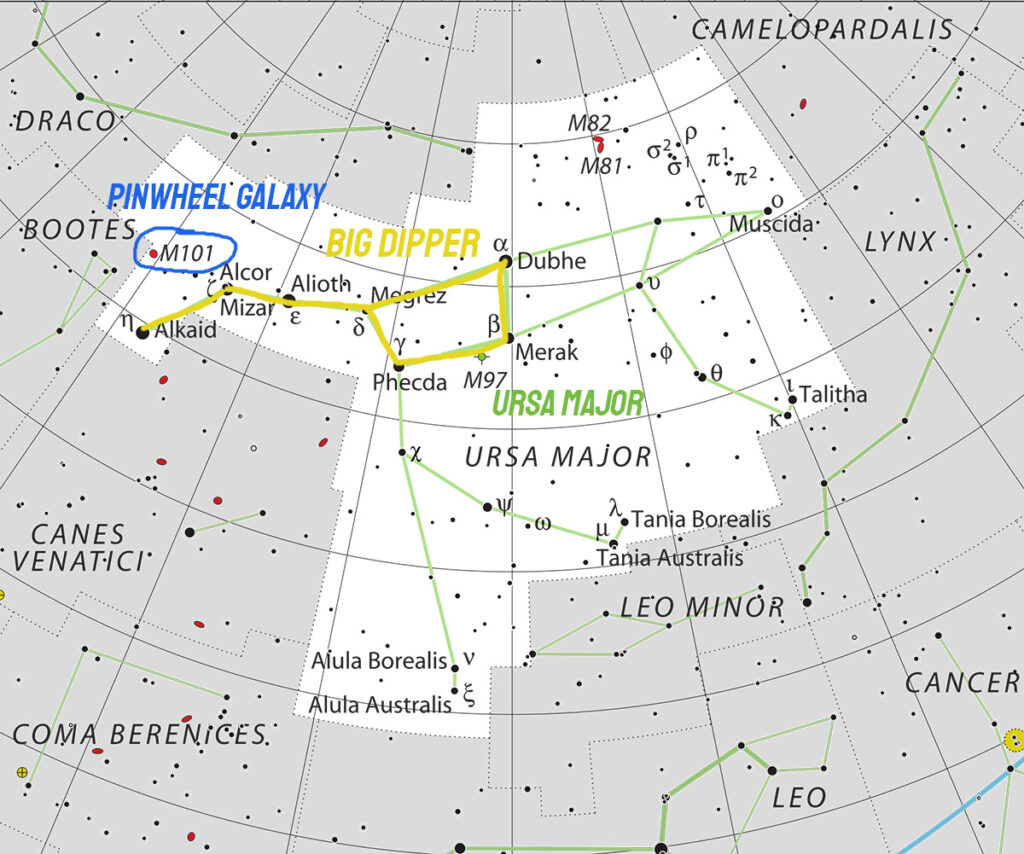
The Pinwheel Galaxy can be seen from all latitudes north of -30, which means it is visible everywhere except the southernmost parts of Argentina, Chile, and Australia.
It can be seen using pretty much any amateur telescope with an aperture of 70mm or more. Here are some recommendations for refractor telescopes for beginners that should be enough.
It is found around the edge of the Ursa Major constellation near the Bootes constellation on what is generally considered the “head” of the bear. Remember that a part of Ursa Major is also known as “The Big Dipper”.
To find the Pinwheel galaxy, locate the handle of the Big Dipper. M101 (The Pinwheel Galaxy) is right between the last two major stars that form the handle. These are Alkor and Alkaid. The image above should give you a better idea of where to locate it.
If you have trouble locating it manually, try a star map application on your smartphone or consider getting a telescope that has star mapping capabilities included like the StarSense Explorer LT 80.
Summary
- The Pinwheel Galaxy is a large, easy-to-see spiral galaxy
- It is considerably bigger and contains 10 times more stars than the Milky Way
- The Pinwheel Galaxy can be found in the Ursa Major constellation, near the handle of the “big dipper”
Enjoyed this article?
Get daily 10-minute PDFs about astronomy to read before bed!
Sign up for our upcoming micro-learning service where you will learn something new about space and beyond every day while winding down.

